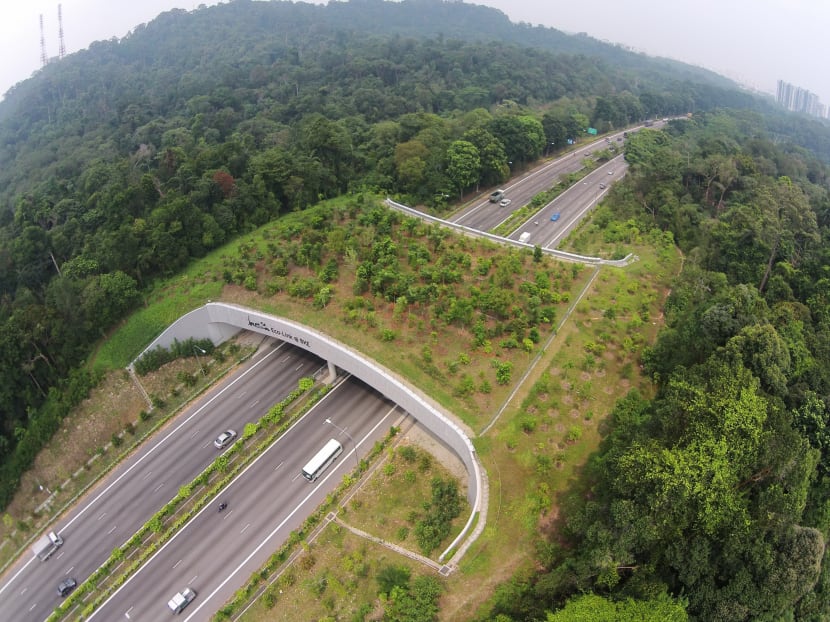Nature-conservation bridge to open for guided tours
SINGAPORE — For the first time, the public will be able to walk along a 62m-long ecological bridge that was built two years ago to create a path for animals to move between Bukit Timah Nature Reserve and Central Catchment Nature Reserve without the risk of being run over by vehicles.
SINGAPORE — For the first time, the public will be able to walk along a 62m-long ecological bridge that was built two years ago to create a path for animals to move between Bukit Timah Nature Reserve and Central Catchment Nature Reserve without the risk of being run over by vehicles.
The bridge, called Eco-Link@BKE, is typically not open to the public to allow animals to use it without human disturbance, and allow the vegetation over it to grow, providing additional cover for wildlife. But the National Parks Board (NParks) is organising guided walks — on four days in all — so that the public can better understand its role in conserving Singapore’s natural heritage.
Bukit Timah Nature Reserve and Central Catchment Nature Reserve were once connected by forest, until the Bukit Timah Expressway (BKE) separated them in 1983.
Since the bridge was built, NParks has seen the number of reported pangolin roadkill fall from an average of about two per year in 1994 to none since 2014.
The agency also said the rarely sighted Sunda Pangolins, which are critically endangered, have also been spotted using the bridge.
The S$16 million bridge was the result of suggestions pooled from the public consultation for the Singapore Green Plan in 2005. Speaking during a media tour today, NParks conservation director Wong Tuan Wah pointed out that Bukit Timah Nature Reserve is much smaller in size as compared to the Central Catchment Nature Reserve.
Hence, the bridge is important in preventing genetic recession and inbreeding, especially for the animal population in Bukit Timah Nature Reserve, as it helps “increase the genetic viability of the population itself and to encourage the animals to live longer”.
NParks said its camera traps on the bridge have captured native animals such as Slender Squirrels, Common Palm Civets and various species of birds and snakes crossing it. The Lesser Mousedeer, which was previously only found in the Central Catchment Nature Reserve, was also spotted earlier this year at the Bukit Timah Nature Reserve.
“While there is no photographic evidence of the Lesser Mousedeer crossing into Bukit Timah Nature Reserve via the Eco-Link@BKE, it is likely that it had used the bridge, as there is no other feasible way,” said NParks.
It added that as the vegetation on the bridge grows taller and denser, more animals are expected to use it, such as the Banded Leaf Monkey, a critically endangered species, the Malayan Colugo, and bird species that are dependent on tall trees and shrubs as cover to move from one area to another.
Senior Minister of State for National Development Desmond Lee told reporters during the media tour: “It is reassuring that the bridge gives (animals) a better chance of survival, and, in fact, to flourish in this highly urbanised Singapore. Because Singapore is not just about concrete, or steel, or glass, or roads, or buildings, it is also about the green spaces that we work very hard and pro-actively to cherish, to protect, and more importantly, to enhance.”
The cameras along Eco-Link@BKE have also captured a less-welcome presence on the bridge — humans. People are not allowed to use the bridge, and NParks will issue a warning, and fine repeat offenders.
The public guided walks will be held on Nov 21, Dec 5 and 19, and Jan 9. During the guided walks, the public will learn about the types of animals that are dependent on the bridge, and how they use it to find safe passage between nature reserves.
Two sessions will be held each day, lasting 90 minutes. The walks are offered free of charge, but prior registration is required on a first-come-first-serve basis and each walk only accommodates 20 people.










